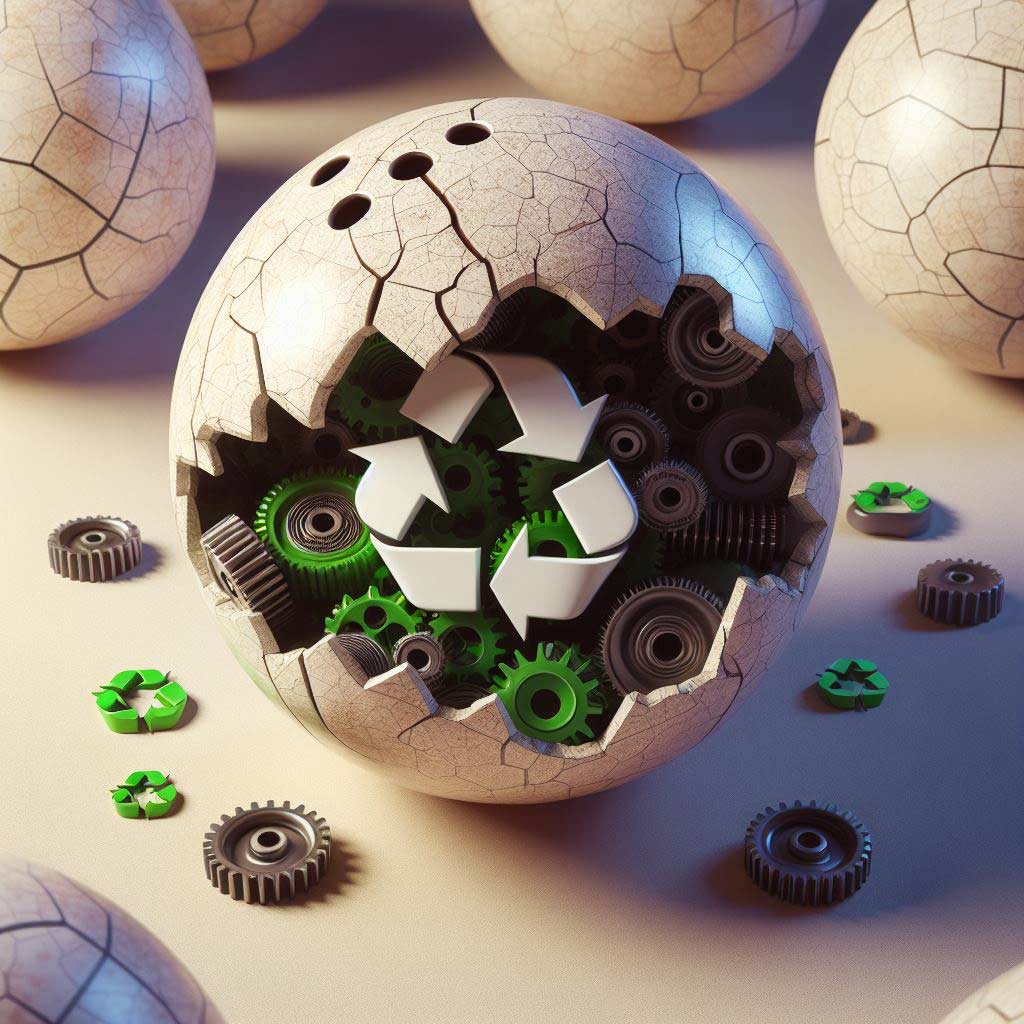Bowling is a beloved pastime enjoyed by millions worldwide, from casual players to competitive athletes. However, as we become more environmentally conscious, the question of what happens to old or damaged bowling balls arises.
These seemingly indestructible spheres are made from unique materials, making traditional recycling a challenge. In this comprehensive guide, we’ll explore whether bowling balls can be recycled and the best practices for responsible disposal.
What Are Bowling Balls Made Of?
The construction of a bowling ball is a marvel of engineering, designed to provide optimal weight distribution, durability, and performance on the lanes.
At the core lies a high-density block, typically made from polyester or plastic resins like polyurethane. This core is then encased in a thick coverstock layer, which can be composed of various materials, including reactive resins, particle blends, or solid surfaces like urethane.
Some bowling balls also incorporate additional components like weight blocks made from dense materials like barium or tungsten. These specialized materials contribute to the overall weight and dynamic properties of the ball but also make traditional recycling more challenging.
Can Bowling Balls Go Into Standard Recycling Streams?
Unfortunately, no – bowling balls cannot simply be tossed into your curbside recycling bin or taken to a standard municipal recycling facility. The unique materials used in their construction, particularly the dense cores and coverstocks, are not compatible with most recycling streams. Attempting to recycle a bowling ball through these channels can lead to contamination and disruptions in the recycling process.
Moreover, improper disposal of bowling balls in landfills poses environmental risks. The dense materials used in their construction can leach harmful chemicals into the soil and groundwater over time, potentially causing long-term damage to ecosystems.
How to Properly Recycle a Bowling Ball
While recycling bowling balls requires specialized facilities, there are options available for responsible disposal. Here’s a step-by-step guide on how to properly recycle your old or damaged bowling balls:
- Contact your local bowling alley or pro shop: Many bowling centers and pro shops participate in recycling programs specifically designed for bowling equipment. They often have partnerships with specialized recyclers that can properly handle the unique materials used in bowling balls.
- Research specialty recyclers: If your local bowling establishment doesn’t offer a recycling program, search online for companies that specialize in recycling bowling balls and other sporting goods. These facilities have the necessary equipment and processes to break down and repurpose the various components.
- Prepare the balls for recycling: Before sending your bowling balls to a recycling facility, follow any specific instructions provided. This may include removing any removable components, such as thumb slugs or finger inserts, and cleaning the balls thoroughly.
- Package and ship: Once prepared, package the bowling balls securely and ship them to the designated recycling facility. Be sure to follow any specific shipping guidelines provided by the recycler.
Environmental Impact of Bowling Ball Recycling
Recycling bowling balls not only reduces landfill waste but also conserves valuable raw materials and energy. The process of recycling and repurposing these materials can have a significantly lower environmental impact than extracting and processing new raw materials from scratch.
According to a lifecycle analysis recently conducted, the carbon footprint of a recycled bowling ball is up to 75% lower than that of a newly manufactured ball. This reduction in emissions and resource consumption can have a profound impact when multiplied across the millions of bowling balls in circulation.
Furthermore, advancements in recycling technologies have made it possible to repurpose various components of bowling balls into new products, such as:
- Recycled polyester and plastic resins for new bowling ball cores or other plastic products
- Recycled coverstock materials for use in flooring, construction materials, or even new bowling ball coverstocks
- Recycled metal components (like tungsten or barium) for use in new industrial applications
By embracing a circular economy approach, the bowling industry can significantly reduce its environmental footprint and contribute to a more sustainable future.
Alternative Uses for Old Bowling Balls
While recycling is the most environmentally responsible option, some creative individuals and organizations have found innovative ways to repurpose old bowling balls, giving them a new life beyond the lanes. Here are a few alternative uses to consider:
- Lawn or garden decorations: With their unique colors and patterns, bowling balls can make eye-catching additions to outdoor spaces. They can be used as planters, garden ornaments, or even outdoor sculptures.
- Children’s play objects: The durable construction of bowling balls makes them a safe and entertaining option for kids to play with in backyard or playground settings. They can be used for games, obstacle courses, or simply as oversized toys.
- Artistic upcycling: Many local artists and organizations have embraced bowling balls as a medium for creative expression. From vibrant painted designs to intricate carvings and sculptures, the possibilities are endless for transforming these spheres into works of art.
- Downcycling into other products: While not the most environmentally friendly option, some companies have explored ways to grind down and repurpose bowling ball materials into other plastic products, such as construction materials, flooring, or even new bowling ball components.
The Future of Bowling Ball Sustainability
As awareness of environmental issues grows, the bowling industry has taken steps towards improving the sustainability of its products. Many manufacturers are exploring the use of more eco-friendly materials in bowling ball construction, such as bio-based resins or recycled plastics.
However, finding a balance between performance and sustainability remains a challenge. Bowling balls must meet strict specifications and durability requirements to ensure consistent play and longevity on the lanes.
One promising development is the emergence of biodegradable or easily recyclable materials that can match the performance of traditional bowling ball components. Researchers are exploring materials like plant-based polymers, which could potentially replace some of the non-renewable plastics currently used.
Consumer demand will also play a crucial role in driving sustainability efforts within the bowling industry. As more bowlers prioritize environmentally conscious products, manufacturers and retailers will be incentivized to invest in greener solutions.
Conclusion:
The responsible disposal and recycling of bowling balls is an important consideration for both individual bowlers and the industry as a whole.
While the unique materials used in these spheres present challenges for traditional recycling streams, specialized facilities and programs exist to properly handle and repurpose these components.
By embracing recycling and exploring alternative uses for old bowling balls, we can reduce the environmental impact of this beloved sport and promote a more sustainable future.
It’s up to all of us – bowlers, manufacturers, and industry leaders – to prioritize responsible practices and drive innovation towards eco-friendly solutions.
If you have old or damaged bowling balls in your possession, take the time to research local recycling options or contact specialized recyclers. Your efforts can make a meaningful difference in reducing waste and conserving valuable resources.
Together, we can strike a balance between our love for the sport and our commitment to environmental stewardship, ensuring that future generations can enjoy the thrill of bowling for years to come.





